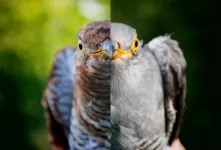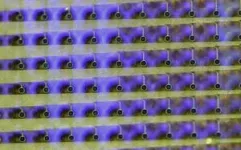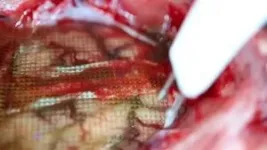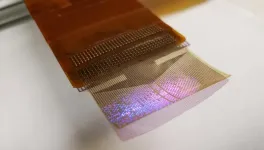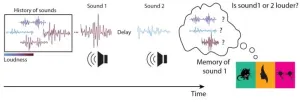(Press-News.org) NEW YORK, April 24, 2024 — Sexual dimorphism—the visible difference between females and males—can be seen in diverse animals, including humans. One intriguing aspect of this phenomenon is sex-limited polymorphism, where one sex displays greater variations in a particular trait than the other. In a recent study published in Science Advances, a team of researchers delve into the genetic underpinnings behind the color polymorphism observed in adult females of the brood parasitic Cuculus, more widely known as cuckoo birds, shedding light on the evolution and functional significance of this phenomenon.
Several species of cuckoos, a genus of birds distributed across Africa and Eurasia, exhibit sex-limited polychromatism (color differences) in their typically striped and hawk-mimetic plumage. Specifically, while adult male cuckoos feature a gray plumage, adult females can display either gray or rufous (reddish-brown) plumage. Furthermore, the prevalence of each female color morph varies between cuckoo species as well as between different populations within the same species.
The internationally collaborative study was initiated by Mark E. Hauber, executive director of the CUNY Advanced Science Research Center (CUNY ASRC) and a psychology professor at the CUNY Graduate Center, in collaboration with a group of Hungarian field ornithologists. For their study, the team employed a genome-wide association analysis on nuclear DNA data, which was obtained from Common and Oriental cuckoos in the wild and from museum specimens. Their aim was to identify candidate genes responsible for the observed polychromatism in adult female cuckoos, the mechanisms of pigmentation underlying the coloration, and the evolutionary history of the mutation.
Genes that affect males and females differently often reside on the sex chromosomes. In mammals, including humans, males represent the heterogametic sex, characterized by their XY sex chromosomes. As such, genes on the Y chromosome exclusively manifest in males, distinguishing them from females with XX chromosomes. Conversely, in birds, females exhibit heterogamy with ZW sex chromosomes, distinct from the ZZ chromosomes of male birds. This disparity led the researchers to hypothesize that the variation in color observed in female cuckoos is likely linked to gene(s) on the female sex chromosome.
“We found that, instead of a single gene or set of genes, nearly all variations in the gray or rufous coloration were associated with the full length of the female-limited W chromosome,” said Hauber. “That was really unexpected.”
Further exploration into the biochemical basis of coloration encoded on the W chromosome uncovered a commonality across the two closely related cuckoo species: both and the Common and Oriental cuckoos utilize two shared forms of melanin-based pigmentation, the same chemical found in human skin pigmentation, to control the intensity of brown and gray coloration in their plumage.
The researchers also utilized genomic data from the two species to examine the evolutionary history of color polymorphism in female cuckoos. Their analysis revealed that a single mutation for female-only polychromatism originated over 1 million years ago in the shared ancestor of these cuckoos, predating species divergence which occurred roughly 140,000 years ago.
The study's findings prompt intriguing questions about the benefits of female’s evolving multiple morphs. Female cuckoos of the less common morph may gain advantages in mimicking rufous juvenile cuckoos to evade the attention of harassing males interested in mating. Additionally, the often-rarer rufous plumage may be strategic for these brood parasite birds, which lay their eggs in the nests of other birds, forcing the hosts to care for their young. The rufous plumage may help females avoid recognition as parasites by potential host species parents, which often attack and occasionally kill adult cuckoos near their nests.
The study transforms our understanding of sex-limited polymorphism and also adds to knowledge regarding sexual dichromatism, highlighting the adaptive advantages that can arise from such intricate evolutionary adaptations.
Article DOI: 10.1126/sciadv.adl5255
About the Advanced Science Research Center at the CUNY Graduate Center
The Advanced Science Research Center at the CUNY Graduate Center (CUNY ASRC) is a world-leading center of scientific excellence that elevates STEM inquiry and education at CUNY and beyond. The CUNY ASRC’s research initiatives span five distinctive, but broadly interconnected disciplines: nanoscience, photonics, neuroscience, structural biology, and environmental sciences. The center promotes a collaborative, interdisciplinary research culture where renowned and emerging scientists advance their discoveries using state-of-the-art equipment and cutting-edge core facilities.
END
Grey cuckoo, red cuckoo: unveiling the genomic secrets of color polymorphism in female cuckoo birds
2024-04-24
ELSE PRESS RELEASES FROM THIS DATE:
CHOP researchers discover underlying biology behind Fontan-associated liver disease
2024-04-24
Philadelphia, April 24, 2024 – As patients with congenital heart diseases live longer, researchers are attempting to understand some of the other complications they may face as they age. In a new study, a team from Children’s Hospital of Philadelphia (CHOP) used state-of-the-art technologies to understand the underlying biology of Fontan-associated liver disease (FALD).
The findings, published today in Science Translational Medicine, reveal unprecedented insights into how the disease develops and potential therapeutic targets for future treatment options.
The Fontan operation is ...
A flexible microdisplay can monitor brain activity in real-time during brain surgery
2024-04-24
A thin film that combines an electrode grid and LEDs can both track and produce a visual representation of the brain’s activity in real-time during surgery–a huge improvement over the current state of the art. The device is designed to provide neurosurgeons visual information about a patient’s brain to monitor brain states during surgical interventions to remove brain lesions including tumors and epileptic tissue.
Each LED in the device mirrors the activity of a few thousand neurons. In a series of proof-of-concept experiments in rodents and large non-primate mammals, researchers showed that ...
Diversity and productivity go branch-in-branch
2024-04-24
Kyoto, Japan -- Climate change can be characterized as the Grim Reaper or some other harbinger of dire times for humanity and natural environment, including forests. Previous studies reporting a decline in forest productivity due to climate warming and long-term drought may suggest that trees' survival hangs in the balance.
Now, a study by an international group, including Kyoto University, found that forests with higher trait diversity not only adapt better to climate change but may also thrive.
The study, conducted by researchers from Lakehead ...
Color variants in cuckoos: the advantages of rareness
2024-04-24
Every cuckoo is an adopted child – raised by foster parents, into whose nest the cuckoo mother smuggled her egg. The cuckoo mother is aided in this subterfuge by her resemblance to a bird of prey. There are two variants of female cuckoos: a gray morph that looks like a sparrowhawk, and a rufous morph. Male cuckoos are always gray.
“With this mimicry, the bird imitates dangerous predators of the host birds, so that they keep their distance instead of attacking,” says Professor Jochen Wolf from LMU Munich. Together with researchers at CIBIO (Centro de Investigação ...
Laser technology offers breakthrough in detecting illegal ivory
2024-04-24
A new way of quickly distinguishing between illegal elephant ivory and legal mammoth tusk ivory could prove critical to fighting the illegal ivory trade. A laser-based approach developed by scientists at the Universities of Bristol and Lancaster, could be used by customs worldwide to aid in the enforcement of illegal ivory from being traded under the guise of legal ivory. Results from the study are published in PLOS ONE today [24 April].
Despite the Convention on the International Trade in Endangered Species (CITES) ban on ivory, poaching associated with its illegal trade has ...
Why can’t robots outrun animals?
2024-04-24
Robotics engineers have worked for decades and invested many millions of research dollars in attempts to create a robot that can walk or run as well as an animal. And yet, it remains the case that many animals are capable of feats that would be impossible for robots that exist today.
“A wildebeest can migrate for thousands of kilometres over rough terrain, a mountain goat can climb up a literal cliff, finding footholds that don't even seem to be there, and cockroaches can lose a leg and not slow down,” ...
After spinal cord injury, neurons wreak havoc on metabolism
2024-04-24
COLUMBUS, Ohio – Conditions such as diabetes, heart attack and vascular diseases commonly diagnosed in people with spinal cord injuries can be traced to abnormal post-injury neuronal activity that causes abdominal fat tissue compounds to leak and pool in the liver and other organs, a new animal study has found.
After discovering the connection between dysregulated neuron function and the breakdown of triglycerides in fat tissue in mice, researchers found that a short course of the drug gabapentin, commonly prescribed for nerve pain, prevented ...
Network model unifies recency and central tendency biases
2024-04-24
Neuroscientists have revealed that recency bias in working memory naturally leads to central tendency bias, the phenomenon where people’s (and animals’) judgements are biased towards the average of previous observations. Their findings may hint at why the phenomenon is so ubiquitous.
Researchers in the Akrami Lab at the Sainsbury Wellcome Centre at UCL and the Clopath Lab at Imperial College London developed a network model with a working memory module and another accounting for sensory histories. The study, published in eLife, describes how the model shows neural circuits ...
Ludwig Lausanne scientists identify and show how to target a key tumor defense against immune attack
2024-04-24
April 24, 2024, NEW YORK – A Ludwig Cancer Research study has discovered how a lipid molecule found at high levels within tumors undermines the anti-cancer immune response and compromises a recently approved immunotherapy known as adoptive cell therapy (ACT) using tumor infiltrating lymphocytes, or TIL-ACT. In this individualized cell therapy, TILs—CD8+ T cells that kill cancer cells—are expanded in culture from a patient’s tumor samples and reinfused into the patient as a treatment.
Researchers led by Ludwig Lausanne’s Matteo ...
Can climate change accelerate transmission of malaria? Pioneering research sheds light on impacts of temperature
2024-04-24
In 2022, an estimated 249 million malaria cases killed 608,000 people in 85 countries worldwide including the United States, according to the World Health Organization.
Malaria continues to pose a considerable public health risk in tropical and subtropical areas, where it impacts human health and economic progress.
Despite concerns about the potential impact of climate change on increasing malaria risk, there is still limited understanding of how temperature affects malaria transmission – until now.
Malaria is a mosquito-borne disease caused by a parasite that spreads from bites of infected female Anopheles mosquitoes. If left untreated in humans, malaria can cause severe symptoms, ...
